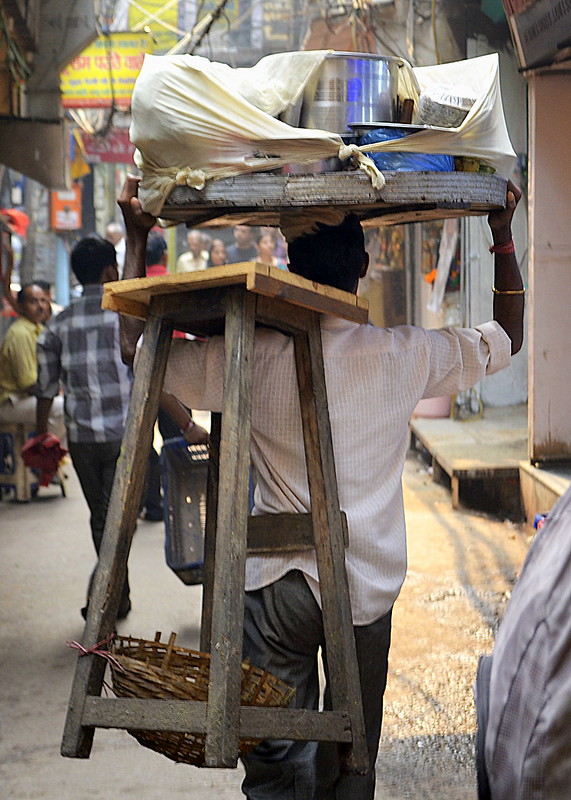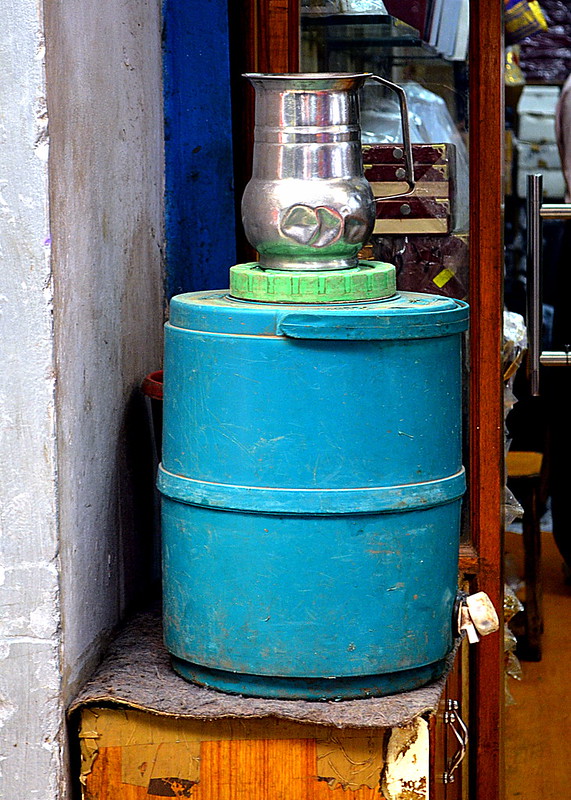It has been said that one of the best ways of getting to a culture’s heart is through its stomach. Sweet words for travelers who go from meal to meal with at least as much joy as they have in going from sight to sight. What a treat to learn things about other cultures (and about ourselves), bite after bite. And so it was that during a recent work trip to New Delhi, India, I had the delightful opportunity to savor Old Delhi’s breakfast culture for a few hours, weaving through narrow streets, dodging people, cars, carts, bicycles, auto-rickshaws, motorcycles, dogs, and the occasional cattle, to find culinary gems–both Hindu and Muslim (the walled city being home to Jama Masjid, the best-known mosque in India)–as the neighborhood awoke. An Indian friend, who knows me so well, arranged this gastronomic tour via Delhi Food Walks. We placed our stomachs in the capable hands of our guide, and dug in.
First, some scenes to set the stage (l-r, top-bottom): a food vendor carrying his wares to a special spot (#1), a renowned Old Delhi chef stirring one of his pots (#2), spices and tea for sale (#3), a dented pitcher atop one of the ubiquitous water containers found throughout the neighborhood (#4), and the very first things we tried for breakfast (#5)–a classic savory-sweet combination: Aloo sabzi (potato curry) in the foreground, eaten with Bedmi poori (hot and fresh in photo #6 below), and Nagori halwa in the background (small crispy semolina poori served with sweet porridge).






After a stop at Karim’s for Nahari Mutton (morning mutton), we then went in search of a famous chickpea dish redolent of coriander, ginger, and tamarind: Lotan ke Chole Kulche (#7). The vendor of this rich specialty had set up shop in a protected nook down a narrow street, where he doled out the dish to throngs of hopefuls waiting with packets of butter in hand. The salty Amul brand butter–available for purchase just up the street from another vendor–added a perfect salty silkiness to the chickpeas, all the better to dip the accompanying bread into. After a brief pit stop to sample some biryani (#8), and then some parathas (#9) at Pundit Gaya Prasad Shiv Charan, it was all about the sweets, starting with sev pak, or sev burfi at Chaina Ram (#10)–-a golden treat made with vermicelli, milk cheese, and lots of sugar. I was so inspired by this particular sweet, that I am experimenting with recreating it at home (update on that to follow).




At this stage, it was definitely time to start expanding our stomachs to make room for the other sugary confections on the menu, a task I was more than willing to undertake since I have the world’s worst (or best?) sweet tooth. And judging by their sweets, so do most Indians–except, amazingly, for my Indian friend and breakfast partner, which meant I had to step up for both of us. Below is a vendor dishing up some pudding-like rabri (#11) at Hazari Lal Jain, which also sells delicious khurchan (#12), creamy layers of “leftover” boiled sweet milk, scraped together and decorated with pistachios and silver foil (varakh). It was very hard to walk away from that khurchan, but even more delights awaited, including warm jalebi (#13 -15), which after going from a hot frying pan into a sugar-syrup bath, are about as sweet as it is possible to imagine. After that, we swore we could not ingest even the smallest morsel more, but we were wrong. One last taste awaited us: Daulat ki Chaat, or sweet milk foam from a cart (#16). Our guide assured it was like a light and airy meringue that would not take up any stomach space at all, and he was right. But after that, even I was done. But, oh, what a morning, and what a glorious taste of India.













